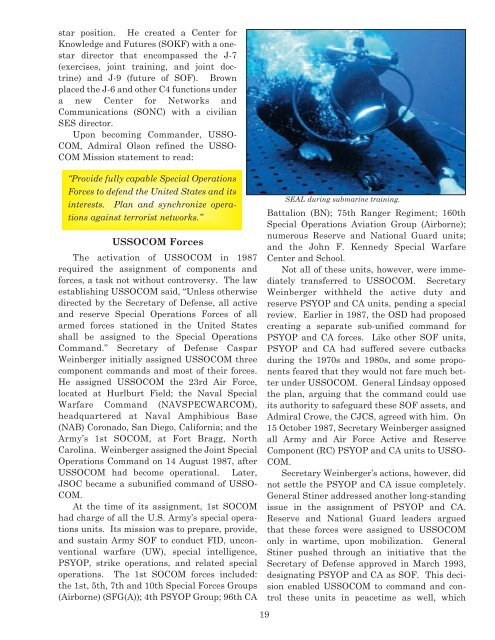HQ$History - United States Special Operations Command
HQ$History - United States Special Operations Command
HQ$History - United States Special Operations Command
Create successful ePaper yourself
Turn your PDF publications into a flip-book with our unique Google optimized e-Paper software.
star position. He created a Center for<br />
Knowledge and Futures (SOKF) with a onestar<br />
director that encompassed the J-7<br />
(exercises, joint training, and joint doctrine)<br />
and J-9 (future of SOF). Brown<br />
placed the J-6 and other C4 functions under<br />
a new Center for Networks and<br />
Communications (SONC) with a civilian<br />
SES director.<br />
Upon becoming <strong>Command</strong>er, USSO-<br />
COM, Admiral Olson refined the USSO-<br />
COM Mission statement to read:<br />
“Provide fully capable <strong>Special</strong> <strong>Operations</strong><br />
Forces to defend the <strong>United</strong> <strong>States</strong> and its<br />
interests. Plan and synchronize operations<br />
against terrorist networks.”<br />
USSOCOM Forces<br />
The activation of USSOCOM in 1987<br />
required the assignment of components and<br />
forces, a task not without controversy. The law<br />
establishing USSOCOM said, “Unless otherwise<br />
directed by the Secretary of Defense, all active<br />
and reserve <strong>Special</strong> <strong>Operations</strong> Forces of all<br />
armed forces stationed in the <strong>United</strong> <strong>States</strong><br />
shall be assigned to the <strong>Special</strong> <strong>Operations</strong><br />
<strong>Command</strong>.” Secretary of Defense Caspar<br />
Weinberger initially assigned USSOCOM three<br />
component commands and most of their forces.<br />
He assigned USSOCOM the 23rd Air Force,<br />
located at Hurlburt Field; the Naval <strong>Special</strong><br />
Warfare <strong>Command</strong> (NAVSPECWARCOM),<br />
headquartered at Naval Amphibious Base<br />
(NAB) Coronado, San Diego, California; and the<br />
Army’s 1st SOCOM, at Fort Bragg, North<br />
Carolina. Weinberger assigned the Joint <strong>Special</strong><br />
<strong>Operations</strong> <strong>Command</strong> on 14 August 1987, after<br />
USSOCOM had become operational. Later,<br />
JSOC became a subunified command of USSO-<br />
COM.<br />
At the time of its assignment, 1st SOCOM<br />
had charge of all the U.S. Army’s special operations<br />
units. Its mission was to prepare, provide,<br />
and sustain Army SOF to conduct FID, unconventional<br />
warfare (UW), special intelligence,<br />
PSYOP, strike operations, and related special<br />
operations. The 1st SOCOM forces included:<br />
the 1st, 5th, 7th and 10th <strong>Special</strong> Forces Groups<br />
(Airborne) (SFG(A)); 4th PSYOP Group; 96th CA<br />
Battalion (BN); 75th Ranger Regiment; 160th<br />
<strong>Special</strong> <strong>Operations</strong> Aviation Group (Airborne);<br />
numerous Reserve and National Guard units;<br />
and the John F. Kennedy <strong>Special</strong> Warfare<br />
Center and School.<br />
Not all of these units, however, were immediately<br />
transferred to USSOCOM. Secretary<br />
Weinberger withheld the active duty and<br />
reserve PSYOP and CA units, pending a special<br />
review. Earlier in 1987, the OSD had proposed<br />
creating a separate sub-unified command for<br />
PSYOP and CA forces. Like other SOF units,<br />
PSYOP and CA had suffered severe cutbacks<br />
during the 1970s and 1980s, and some proponents<br />
feared that they would not fare much better<br />
under USSOCOM. General Lindsay opposed<br />
the plan, arguing that the command could use<br />
its authority to safeguard these SOF assets, and<br />
Admiral Crowe, the CJCS, agreed with him. On<br />
15 October 1987, Secretary Weinberger assigned<br />
all Army and Air Force Active and Reserve<br />
Component (RC) PSYOP and CA units to USSO-<br />
COM.<br />
Secretary Weinberger’s actions, however, did<br />
not settle the PSYOP and CA issue completely.<br />
General Stiner addressed another long-standing<br />
issue in the assignment of PSYOP and CA.<br />
Reserve and National Guard leaders argued<br />
that these forces were assigned to USSOCOM<br />
only in wartime, upon mobilization. General<br />
Stiner pushed through an initiative that the<br />
Secretary of Defense approved in March 1993,<br />
designating PSYOP and CA as SOF. This decision<br />
enabled USSOCOM to command and control<br />
these units in peacetime as well, which<br />
19<br />
SEAL during submarine training.

















